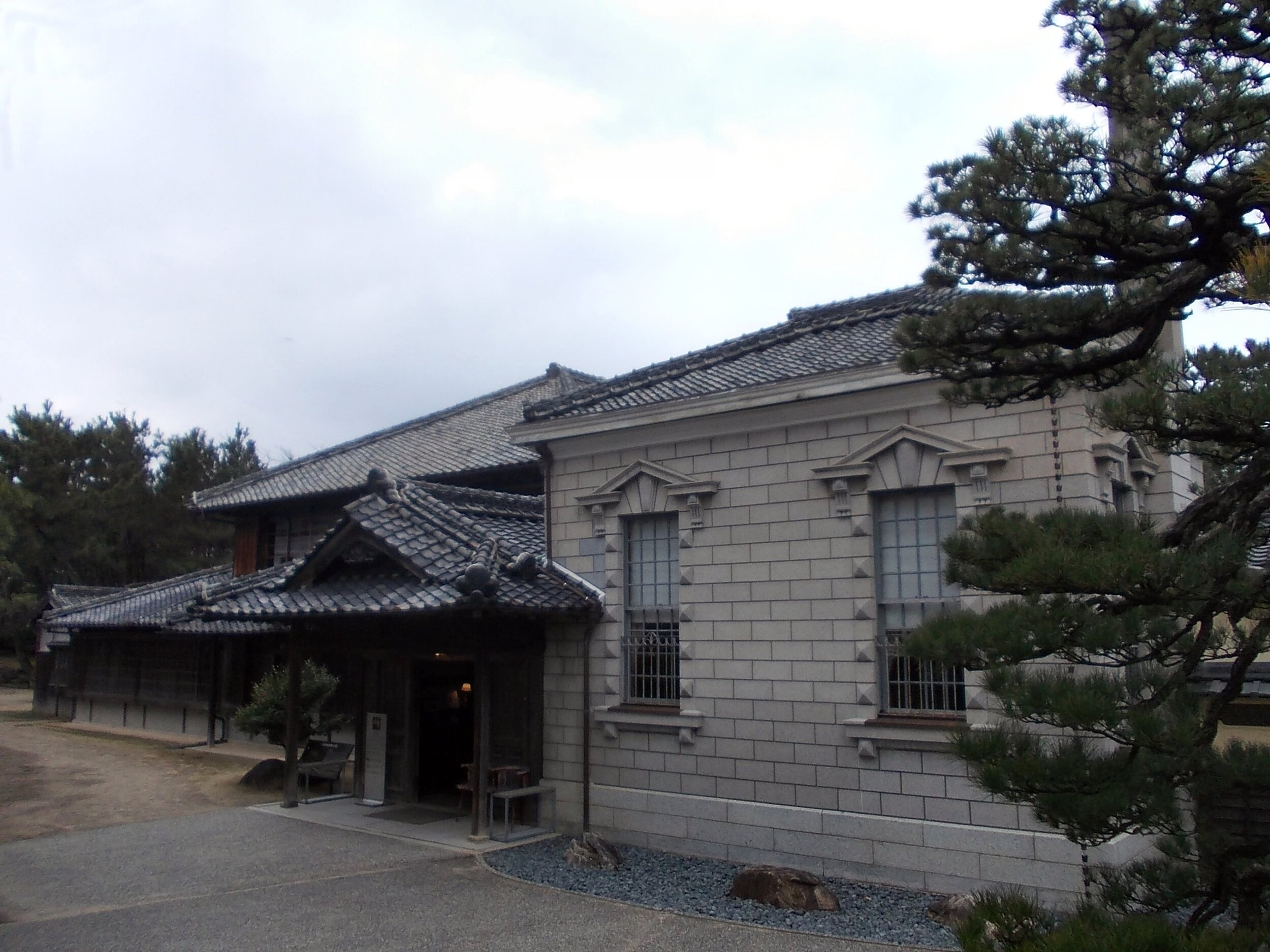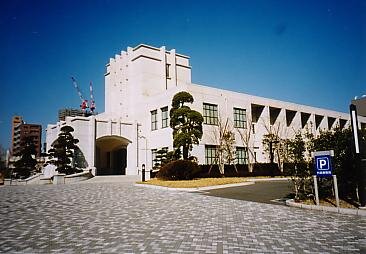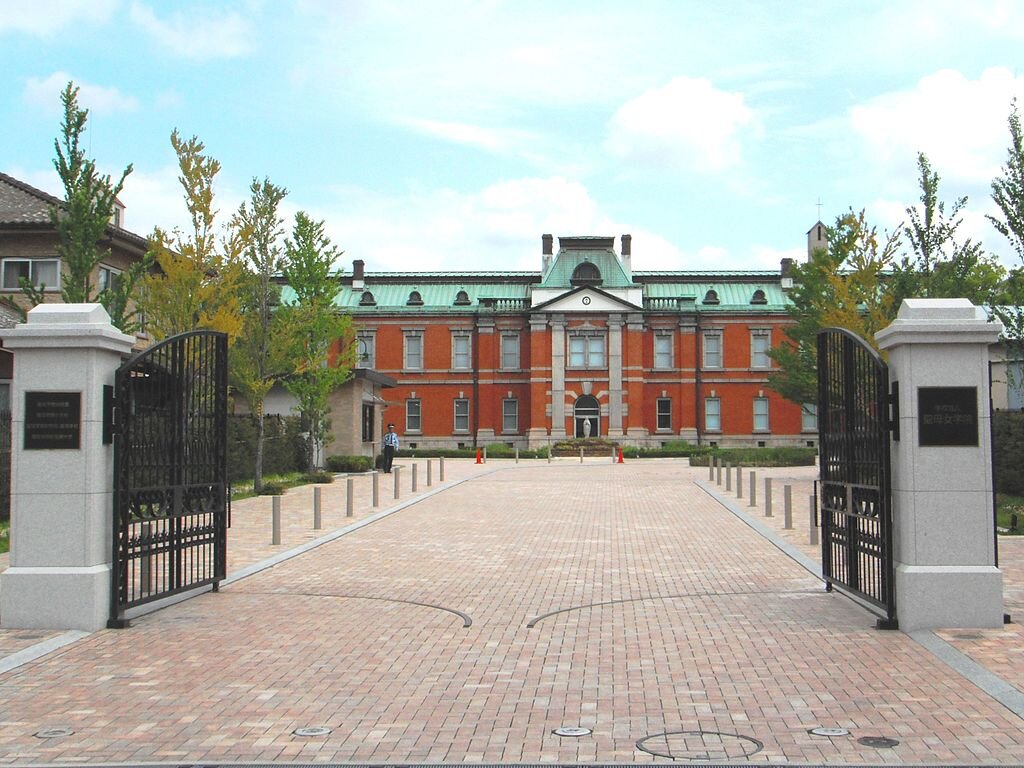Tanba Mangan Kinenkan
Emergence of Contestation: 1989
The Tanba Mangan Kinenkan is a small private museum near Kyoto which houses information on the conscription of Korean labourers in the early twentieth century
Museum Education through Reenactment: Considering Historical Sites in Korea and Japan - Jason Mark Alexander
Takatori Residence
The Former Takatori Residence ( is a residential compound built in the late-Meiji period by Takatori Koreyoshi, a local coal entrepreneur . The building is located in the city of Karatsu, in the northwestern part of Saga Prefecture, and it was elevated to the status of Important Cultural Property in 2005. The exterior structure is characterized by a fusion of two distinctive styles: the main façade is constituted by a building in what appears to be Western-style stone masonry, and is flanked by the main structure built in traditional Japanese timber architecture.
Takatori Residence - Arisha Satari
Puppet Emperor Palace Museum
Emergence of Contestation: 1984
The Puppet Emperor Palace, dedicated to China's emperor Puyi, is at present designed to serve as a "site of memory" for the emperor's life journey from the throne to becoming an ordinary citizen of the newly formed Chinese state, as well as a symbol of China's successfull wartime struggle against the Japanese rule (specifically Japan's puppet government in Manchukuo). However, the site itself did not serve as the stage for most of Puyi's conversion, nor did it figure prominently in the Chinese resistance, which seemingly somewhat undermines its claim to the "site of memory" title. A consideration of the actual history of active Japanese governance associated with the site (as opposed to the "victim narrative" carefully constructed by the CCP) could restore this title to the museum, but would require a departure from the official Party narrative aimed at centering national legitimacy.
Beyond a "Site of Memory": The Puppet Emperor Palace Museum - Emily Matson
National Memorial Museum
Emergence of Contestation: 2014
The National Memorial Museum of Korea in Pusan focuses on the Japanese conscription of Korean labourers during the period of colonial expansion, focussing particularly on the lived experiences of the colonized.
Museum Education through Reenactment: Considering Historical Sites in Korea and Japan - Jason Mark Alexander
https://www.flickr.com/photos/kiyong2/49037497296/
Mimizuka (Ear Mound)
Emergence of Contestation: 1597
The Mimizuka memorial can serve as an example of a transformative mnemonic site, where meaning and memory of conflict is continuously reshaped through time. The representations of the monument and the collective memories associated with it shift between communities, generating narratives ranging from reproach to remembrance, and even reconciliation, all the while fueling discussion on how memorialisation is handled in today's society.
Kyoto's Mimizuka: Transformation and Contestation Across Four Centuries - Daniel Milne
Futenma Airbase
Emergence of Contestation: 2015
The relocation of the Futenma airbase to Henoko in Naga is accompanied by a spectrum of reactions which cannot easily be covered by the duality of simply being "for" or "against" the move. In the case of Komeito politicians, there exists a marked split in the positions of the party's local representatives ("against"), and the national representatives (reluctant support), which demonstrates that the common perceptions of left-wing and right-wing politics fail to cover the complexity of the socio-economic and political reality, as well as the intricate dynamics of local, national, and international issues.
Negotiating Historical Memory in an Era of Purity Politics - Anne Mette Fisker-Nielsen
Okawa Elementary School
Emergence of Contestation: 2011
In the wake of the March 2011 disasters in Tohoku, several remaining ruins have become sites of negative heritage. This site - at which the failure to manage the evacuation of pupils led to tragedy - has been subject of a debate between survivors and the Japanese government, with the former wanting to preserve the school buildings, and the latter seeking to demolish them.
Framing Negative Heritage in Disaster Risk Education: School Memorials After 3.11 - Julia Gerster, Flavia Fulco
Ichigaya Memorial Hall
Emergence of Contestation: 1946, 1990s
The courtroom at the Ichigaya site where the International Military Tribunal for the Far East was held has been preserved through a collaborative effort of conservative and progressive activists. The site was supposedly to commemorate either the Japanese wartime crimes, or the allies' victor's justice over the defeated Japanese leaders. When contrasted with the site of the Nuremberg Trials, however, the site draws little attention to the war trials themselves. Moreover, the items exhibited at Ichigaya make a bias in favour of the "victor's justice" narrative apparent.
Competing Memories of Victor's Justice vs Aggressive Warfare at Ichigaya Memorial - André Hertrich
Ainu Remains
Emergence of Contestation: 1869
The Ainu human remains stolen from Hokkaido gravesites for scientific purposes in the period of the Japanese colonisation of Hokkaido are presently still housed in museum collections across the globe, provoking protest from Ainu activists who demand their return. The remains themselves have become sites of memory through which Japanese colonial amnesia is challenged.
Stolen Ainu Remains as Sites of Memory - Michael Roellinghoff
Comfort Women Statue (Seoul)
Emergence of Contestation: 1991, 2011
The Statue of Peace serves as a memorial to young Korean women who became victims of the Japanese wartime military prostitution system. The physical placement of the Statue is Seoul opposite the Japanese embassy was highly symbolic of the victims' waiting for a full and formal apology. However, its reach and the political pressure it could exert were amplified through digital reproduction, which ultimately allowed for a global debate to be kindled. Understanding the Statue in the context of visual politics allows for understanding its rise as a symbol of resistance.
Visualising Korea: The Politics of the Statue of Peace - David Chapman
Meiji Shrine
Emergence of Contestation: 1912
The Meiji Shrine today is a popular tourist destination, and a site for a wide variety of events and festivities. However, the Shrine also functions as a mnemonic site with various audiences, and is attached with a complex web of meanings, - at times seemingly contradictory, - from the veneration of the Meiji emperor to a symbol of postwar democratisation. The Shrine is a centre not only for religious life, but also for historical consciousness.
Forgetting War and Remembering Progress at the Meiji Shrine - Peter Zarrow
Tsugaru Storytelling
The "Wa no mukashi-ko" storytellers from the Tsugaru region in Aomori construct heritage through inherited oral folklore recited in dialect, which they adapt and pass on to the local people. This vernacular tradition stands in contrast with the hegemonic discourse of authenticity linked to the region through narratives manufactured in the country's centre in Tokyo.
The Inheritance of Voice, Intentionality, and Provincial Japan: Storytelling in Tsugaru - Joshua Lee Solomon
Kyoto War Heritage
Emergence of Contestation: 1945
Members of the 16th Division of the Imperial Japanese Army stationed in Kyoto were sent out across the Asia-Pacific, linking various sites across the city to Japan's military past. This past and the associated sites, however, are conspicuously absent from Kyoto's tourism landscape, and remain a negative heritage, yet to be dealt with.
Kyoto's Contested Asia-Pacific War Heritage: Sites of the Army's 16th Division - Justin Aukema
Christian Sites of Nagasaki
Emergence of Contestation: 1600s, 2018
The Nagasaki region features a number of historic sites of hidden Christian worship. The sites serve both the goals of institutional tourism as internationally recognised Japanese heritage, and the narratives of local guides as sites of importance to rural folk culture. Neither narrative can be considered the dominant one.
World Heritage, Tourism, and Cultural Intimacy in Nagasaki - Raluca Mateoc
Hokkaido Jingu
Emergence of Contestation: 1869, 1895, 1945, 1949-1987
The Shinto shrines built over time along the expanding Imperial Japanese border carried different associations in different locations across varying points in time. While the shrines in Hokkaido retained a religious association even after the war and were linked to the pioneer narrative, in colonial Taiwan the shrines were primarily locations of patriotic worship of the dead, and, as they became set as secular after the war, they transformed into symbols of a multicultural Taiwan.
Desecration or Veneration: The Legacy of Shinto Shrines at the Borders of Imperial Japan - Karli Shimizu
Arahama Elementary School
Emergence of Contestation: 2011
In the wake of the March 2011 disasters in Tohoku, several remaining ruins have become sites of negative heritage. This site - an example of a successful evacuation - is being preserved as a monument to the importance of disaster preparation (BOSAI).
Framing Negative Heritage in Disaster Risk Education: School Memorials After 3.11 - Julia Gerster, Flavia Fulco






























